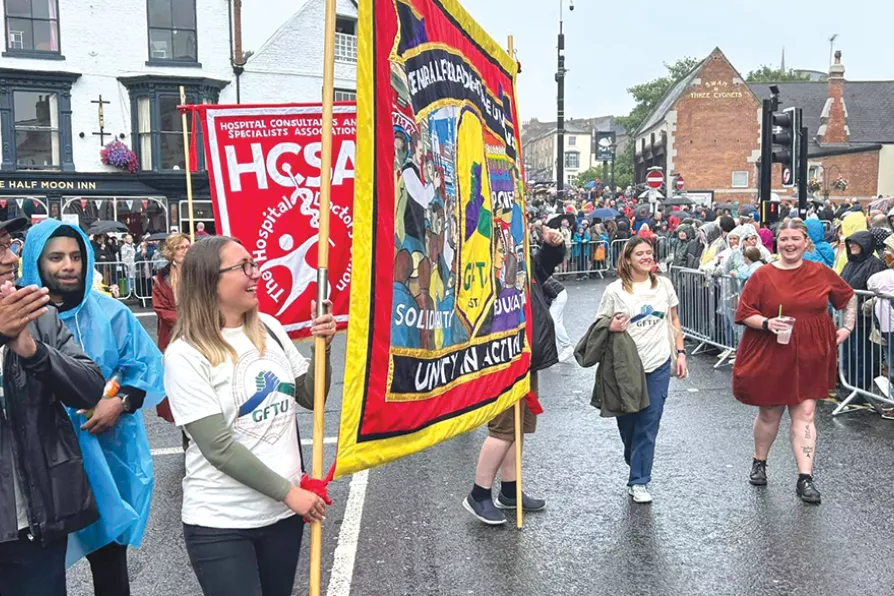It is only trade union power at work that will materially improve the lot of working people as a class but without sector-wide collective bargaining and a right to take sympathetic strike action, we are hamstrung in the fight to tilt back the balance of power, argues ADRIAN WEIR

 PRESENT AND CORRECT: The GFTU banner is paraded last week during the 2024 Durham Miners’ Gala
[GFTU]
PRESENT AND CORRECT: The GFTU banner is paraded last week during the 2024 Durham Miners’ Gala
[GFTU] ONE hundred and twenty five years ago this weekend, the General Federation of Trade Unions (GFTU) held its founding conference.
Delegates from 44 unions, representing between them 310,437 members came together to build an industrial federation capable of taking on the might of the employers’ combinations.
The unions represented included the Amalgamated Society of Engineers; the National Union of Boot and Shoe Operatives; the National Union of Gasworkers and General Labourers; The Dock, Warf, Riverside and General Workers’ Union and many others.
The 1897-98 engineering lock-out had taught trade unionists that a divided movement was not capable of taking on employers who, whatever their individual differences, would come together during a strike to ensure they smashed the workers and pushed back their demands: “We employers are at last coming together to see that our interests — and the interests of capital — are properly protected,” says Mr Birling in JB Priestley’s An Inspector Calls.
Similarly, the London dock strike just a decade earlier proved that united unions could win.
In response to the 1897-98 lockout, the movement within the TUC to create new organisations to advance workers’ interests gathered pace.
This led to the formation of the GFTU in 1899 and of the Labour Representation Committee (later to become the Labour Party) in 1900.
Both of these organisations were created by the TUC, the central body of the trade union movement, to drive forward the struggle of working people.
Just as the founding aims of the Labour Representation Committee committed it to “promoting legislation in the direct interests of labour,” so the founding aims of the GFTU set out to “secure for workers the power to determine the economic and social conditions under which they shall work and live.”
These aims were radical at the time, and remain so today, because they extend beyond purely workplace concerns to the direct interests of working people and the economic and social conditions in which they work and live.
Both organisations were founded by the TUC to change society by empowering workers and winning legislation. They were a recognition of the need for both industrial and political struggle to change society, and the need to combine these struggles.
They also both rested on a growing understanding of the economic basis of society, of the relationship between labour and capital. This understanding was being popularised by figures like Tom Mann of the Dock, Warf, Riverside and General Workers’ Union and was sharpened by both the dock strike and the engineering lockout.
Without this growing understanding of economics, and of the nature of wage labour and exploitation, the new unionism of 1880s and 1890s, of which the GFTU was a part, would not have developed along the lines it did and the modern trade union movement would look very different.
[[{"fid":"67499","view_mode":"inlinefull","fields":{"format":"inlinefull","field_file_image_alt_text[und][0][value]":"GUIDING THOUGHT: The back of the GFTU banner shown to the crowds at the 2024 Durham Miners’ Gala [Pic: Photo GFTU]","field_file_image_title_text[und][0][value]":false},"link_text":null,"type":"media","field_deltas":{"1":{"format":"inlinefull","field_file_image_alt_text[und][0][value]":"GUIDING THOUGHT: The back of the GFTU banner shown to the crowds at the 2024 Durham Miners’ Gala [Pic: Photo GFTU]","field_file_image_title_text[und][0][value]":false}},"attributes":{"alt":"GUIDING THOUGHT: The back of the GFTU banner shown to the crowds at the 2024 Durham Miners’ Gala [Pic: Photo GFTU]","class":"media-element file-inlinefull","data-delta":"1"}}]]
Fast forward to today and we have an entirely different situation.
The Labour Party, which in 1899 was one year away from its early beginnings in the LRC, has just formed a government and is already preparing legislation to improve workers’ rights and take a major piece of our transport infrastructure back into public ownership.
The GFTU is now a thriving federation of specialist trade unions with over half a million affiliated members, and has just launched its biggest and broadest programme of trade union education yet.
However, that growing understanding of political economy which played a role in shaping the developments of the 1890s has receded.
Neoclassical economics is in the ascendancy and workers’ understanding of how our economy works is at a low ebb.
The new Labour government provides an opportunity for change, to reinvest in the productive economy and correct the supply side weaknesses that have made us particularly susceptible to economic crisis in recent years.
It provides an opportunity to reset the relationship between workers and bosses, and to begin to undo the massive transfer of wealth from working people to the super-rich that has taken place over the last 45 years.
However, Labour will come under increasing pressure not to act, not to reverse the damage caused by neoliberalism, not to reframe our economy in the interests of the many, not the few.
If the Labour government provides the opportunity for change, it is the strength of our unions that provides the means to seize that opportunity. And that includes the ability of rank-and-file union members to articulate what is wrong with our economy and the change we want to see.
That is why we are so pleased, in our 125th year, to be working with Soas at the University of London on a new partnership which aims to deliver economic education right across the trade union movement, to equip working people with the economic understanding and the tools to shape their own future.
The emancipation of the working class must be the work of the working class itself.
Gawain Little is the general secretary of the General Federation of Trade Unions (GFTU).














